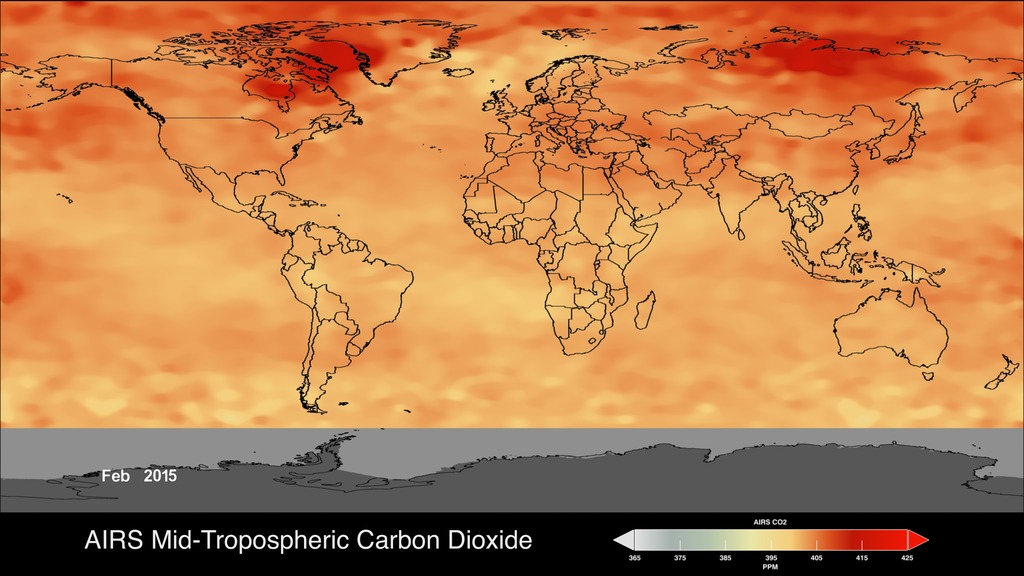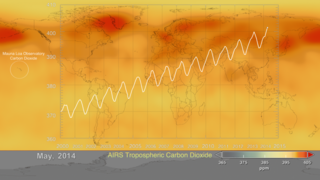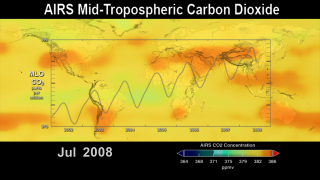Earth
ID: 4533
This visualization is an update of the global distribution and variation of the concentration of mid-tropospheric carbon dioxide observed by the Atmospheric Infrared Sounder (AIRS) on the NASA Aqua spacecraft. For comparison, it is overlain by a graph of the seasonal variation and interannual increase of carbon dioxide observed at the Mauna Loa, Hawaii observatory.
The two most notable features of this visualization are the seasonal variation of CO2 and the trend of increase in its concentration from year to year. The global map clearly shows that the CO2 in the northern hemisphere peaks in April-May and then drops to a minimum in September-October. Although the seasonal cycle is less pronounced in the southern hemisphere it is opposite to that in the northern hemisphere. This seasonal cycle is governed by the growth cycle of plants. The northern hemisphere has the majority of the land masses, and so the amplitude of the cycle is greater in that hemisphere. The overall color of the map shifts toward the red with advancing time due to the annual increase of CO2.


Atmospheric CO2 from AIRS 2002-2016
The two most notable features of this visualization are the seasonal variation of CO2 and the trend of increase in its concentration from year to year. The global map clearly shows that the CO2 in the northern hemisphere peaks in April-May and then drops to a minimum in September-October. Although the seasonal cycle is less pronounced in the southern hemisphere it is opposite to that in the northern hemisphere. This seasonal cycle is governed by the growth cycle of plants. The northern hemisphere has the majority of the land masses, and so the amplitude of the cycle is greater in that hemisphere. The overall color of the map shifts toward the red with advancing time due to the annual increase of CO2.


Older Versions
Visualization Credits
Cheng Zhang (USRA): Lead Visualizer
Lori Perkins (NASA/GSFC): Visualizer
Edward Olsen (NASA/JPL CalTech): Lead Scientist
Sharon Ray (NASA/JPL CalTech): Project Support
Tom Pagano (NASA/JPL CalTech): Scientist
Lori Perkins (NASA/GSFC): Visualizer
Edward Olsen (NASA/JPL CalTech): Lead Scientist
Sharon Ray (NASA/JPL CalTech): Project Support
Tom Pagano (NASA/JPL CalTech): Scientist
Please give credit for this item to:
NASA's Scientific Visualization Studio
NASA's Scientific Visualization Studio
Short URL to share this page:
https://svs.gsfc.nasa.gov/4533
Data Used:
Note: While we identify the data sets used in these visualizations, we do not store any further details nor the data sets themselves on our site.
Keywords:
SVS >> CO2
SVS >> Hyperwall
SVS >> AIRS
NASA Science >> Earth
NASA Earth Science Focus Areas >> Carbon Cycle and Ecosystems
https://svs.gsfc.nasa.gov/4533
Data Used:
Aqua/AIRS/Monthly CO2 V6 also referred to as: Monthly CO2
Observed Data - AIRS
Monthly CO2 from AIRS DAAC.
Keywords:
SVS >> CO2
SVS >> Hyperwall
SVS >> AIRS
NASA Science >> Earth
NASA Earth Science Focus Areas >> Carbon Cycle and Ecosystems













